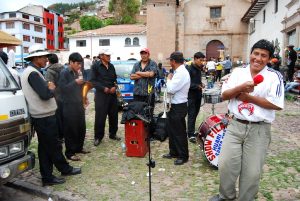Musicians Make Cuzco Celebrate, the Kaperos of Cuzco

While walking around Cuzco’s Plaza de Armas (Main Square) on the day of Corpus Christi, my ears were filled with commotion from the thunderous blows on bass drums, the beating of snare drums, the squeals of trumpets and the snapping of cymbals as the groups called kaperos walked behind every saint and every dance troupe.
The kaperos are musicians in different groups, bands and orchestras. They always gather together for the different patronal feasts carried out in our city since there is great demand for them.
When the saints and dancers pass through Cuzco’s streets in a pasacalle these groups made up of musicians playing different instruments makes two, three, or four turns through an area. The different troupes of dancers and sponsors of the feasts contract with them to accompany them with their music around the plaza and through the streets. During the feast the City lives through an intense celebrations as a show of devotion to the fourteen patron saints of Cuzco.
Before entering the Cathedral, the saints move through the streets of Cuzco’s historic center blessing businesses and other institutions that are along their path. The carguyoq, those who have the responsibility to sponsor the feast, accompanied by the bands of kaperos, travel through Cuzco until they reach the Cathedral.
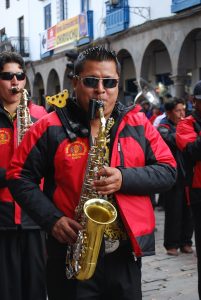
Along the way people make donations for the images of money, incense, coronas of flowers, candles, flower arrangements, and even food. Sometimes they are given to social causes in the name of the Saint and God.

The musicians play as they walk behind the saints. Almost always each has its own musical groups. Many times those who play ore devotees of that same saint. When this is the case they play many times simply as an act of faith and not to receive any other remuneration.
On finishing the procession the images return once again to the Cathedral where they will stay for 8 days before once again making their way back to their home parishes, temples, and churches, accompanied again by musicians.
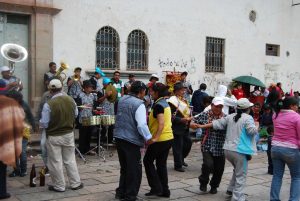
Faces are transformed by faith, feet bare, candles lighted, and songs sung in Quechua and Spanish. Everything is fiesta. While the dancers and the kaperos show their vibrant color along the way, the people of Cuzco await them content to see their saint passing by to fill it with their prayers.
In the feast of the various patron saints of Cuzco’s neighborhoods, each carried out on a different date, everything is fiesta and it focuses around the sponsors, the carguyoq. They arrive dressed in their finest clothes making their best steps to the music of their kaperos as an offering of devotion to their holy patrons or patronesses.
Nevertheless, their bombards, orchestras, and bands of musicians–their kaperos–announce from the moment they begin to play that the celebration has begun. They convert a traditional district of the city of Cuzco into a true feast and fiesta.
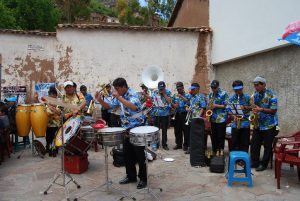
The musicians live in different parts of the city. In the school in which I studied, the Gran Unidad Escolar Garcilaso de la Vega, I would always see my mates participate in the band and learn music. They would practice in the soccer field. Now I see them in the streets of Cuzco playing as kaperos.
On the Thursday of Compadres or the Thursday of Comadres in which people celebrate the ties that joins them through godparent-hood tied to the Catholic Church, the co-godparents go to mass together accompanied by the sound of kaperos. On finishing the mass, outside the church’s doors the people are invited by the carguyoq, or feast sponsor, to enjoy a foamy drink called ponche made from fava beans or Brazil nuts spiked with distilled cane alcohol, cañazo, along with hors d’oeuvres to drive away the chill of Cuzco mornings.
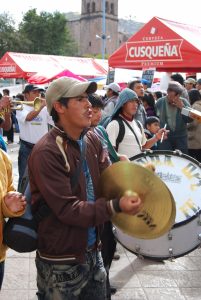
During the day, all of those present are adorned on their heads and necks with colorful streamers and with confetti. Their faces are painted with talcum powder in colors. All of this is part of the joy, laughter, jokes, and much drink. Beer, chicha and other alcoholic beverages flow liberally. Cherry bombs, rockets, and fire crackers are also present in these celebrations.
As the kaperos continue playing, the feast ends in the homes of the carguyoq, after everyone has eaten the meal the carguyoq had prepared and served. Many times it is a chicken soup, a puchero (stew), and adobo, or a chiriucho among other possible traditional dishes rom our region. Everyone present, makes the food go down with a glass of chicha, beer, or some other drink. The feast continues to the las consequences and the kaperos stay there celebrating, eating, drinking, and more than anything else making music. They are with everyone and greeting everyone.
